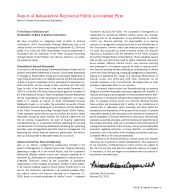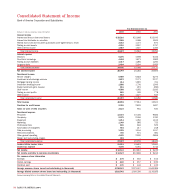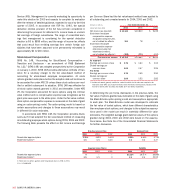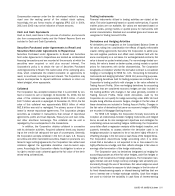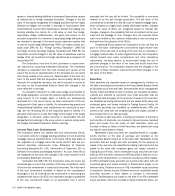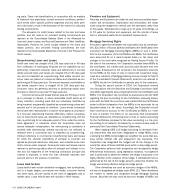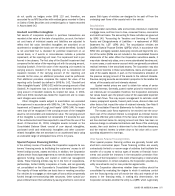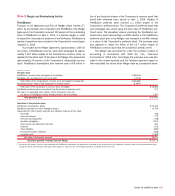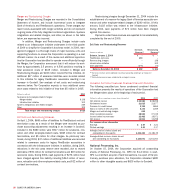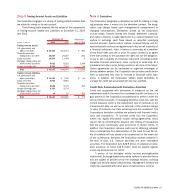Bank of America 2004 Annual Report Download - page 105
Download and view the complete annual report
Please find page 105 of the 2004 Bank of America annual report below. You can navigate through the pages in the report by either clicking on the pages listed below, or by using the keyword search tool below to find specific information within the annual report.
assets or interest-bearing liabilities or forecasted transactions caused
by interest rate or foreign exchange fluctuation. Changes in the fair
value of derivatives designated for hedging activities that are highly
effective as hedges are recorded in earnings or Accumulated Other
Comprehensive Income (OCI), depending on whether the hedging rela-
tionship satisfies the criteria for a fair value or cash flow hedge,
respectively. Hedge ineffectiveness, and gains and losses on the
excluded component of a derivative in assessing hedge effectiveness
are recorded in earnings in the same income statement caption that
is used to record hedge effectiveness. SFAS 133 retains certain con-
cepts under SFAS No. 52, “Foreign Currency Translation,” (SFAS 52)
for foreign currency exchange hedging. Consistent with SFAS 52, the
Corporation records changes in the fair value of derivatives used as
hedges of the net investment in foreign operations as a component of
Accumulated OCI.
The Corporation, from time to time, purchases or issues finan-
cial instruments containing embedded derivatives. The embedded
derivative is separated from the host contract and carried at fair
value if the economic characteristics of the derivative are not clearly
and closely related to the economic characteristics of the host con-
tract. To the extent that the Corporation cannot reliably identify and
measure the embedded derivative, the entire contract is carried at
fair value on the Consolidated Balance Sheet with changes in fair
value reflected in earnings.
If a derivative instrument in a fair value hedge is terminated or
the hedge designation removed, the previous adjustments of the car-
rying amount of the hedged asset or liability are subsequently
accounted for in the same manner as other components of the car-
rying amount of that asset or liability. For interest-earning assets and
interest-bearing liabilities, such adjustments are amortized to earn-
ings over the remaining life of the respective asset or liability. If a
derivative instrument in a cash flow hedge is terminated or the hedge
designation is removed, related amounts in Accumulated OCI are
reclassified into earnings in the same period or periods during which
the hedged forecasted transaction affects earnings.
Interest Rate Lock Commitments
The Corporation enters into interest rate lock commitments (IRLCs)
in connection with its mortgage banking activities to fund residential
mortgage loans at specified times in the future. IRLCs that relate to
the origination of mortgage loans that will be held for sale are con-
sidered derivative instruments under Statement of Financial
Accounting Standards No. 149, “Amendment of Statement 133 on
Derivative Instruments and Hedging Activities”. As such, these IRLCs
are recognized at fair value with changes in fair value recorded in the
Consolidated Statement of Income.
Consistent with SAB 105, the Corporation does not record any
unrealized gain or loss at the inception of the loan commitment, which
is the time the commitment is issued to the borrower. The initial value
of the loan commitment derivative is based on the consideration
exchanged, if any, for entering into the commitment. In estimating the
subsequent fair value of an IRLC, the Corporation assigns a probability
to the loan commitment based on an expectation that it will be
exercised and the loan will be funded. This probability is commonly
referred to as the pull through assumption. The fair value of the
commitments is derived from the fair value of related mortgage loans,
which is based on a highly liquid, readily observable market. Changes
to the fair value of IRLCs are recognized based on interest rate
changes, changes in the probability that the commitment will be exer-
cised and the passage of time. Changes from the expected future
cash flows related to the customer relationship or loan servicing are
excluded from the valuation of the IRLCs.
Outstanding IRLCs expose the Corporation to the risk that the
price of the loans underlying the commitments might decline from
inception of the rate lock to funding of the loan due to increases in
mortgage interest rates. To protect against this risk, the Corporation
utilizes forward loan sales commitments and other derivatives
instruments, including options, to economically hedge the risk of
potential changes in the value of the loans that would result from
the commitments. The Corporation expects that the changes in the
fair value of these derivative instruments will offset changes in the
fair value of the IRLCs.
Securities
Debt securities are classified based on management’s intention on
the date of purchase and recorded on the Consolidated Balance Sheet
as Securities as of the trade date. Debt securities which management
has the intent and ability to hold to maturity are classified as held-to-
maturity and reported at amortized cost. Debt securities that are
bought and held principally for the purpose of resale in the near term
are classified as trading instruments and are stated at fair value with
unrealized gains and losses included in Trading Account Profits. All
other debt securities are classified as available-for-sale (AFS) and
carried at fair value with net unrealized gains and losses included in
Accumulated OCI on an after-tax basis.
Interest on debt securities, including amortization of premiums
and accretion of discounts, are included in Interest Income. Realized
gains and losses from the sales of debt securities, which are
included in Gains on Sales of Debt Securities, are determined using
the specific identification method.
Marketable equity securities are classified based on manage-
ment’s intention on the date of purchase and recorded on the
Consolidated Balance Sheet as of the trade date. Marketable equity
securities that are bought and held principally for the purpose of
resale in the near term are classified as trading instruments and are
stated at fair value with unrealized gains and losses included in
Trading Account Profits. Other marketable equity securities are clas-
sified as AFS and either recorded as AFS Securities if they are a com-
ponent of the ALM portfolio, or otherwise recorded as Other Assets.
All AFS marketable equity securities are carried at fair value with net
unrealized gains and losses included in Shareholders’ Equity on an
after-tax basis. Dividend income on AFS marketable equity securities
is included in Interest Income. Dividend income on marketable equity
securities recorded in Other Assets is included in Noninterest
Income. Realized gains and losses on the sale of all AFS marketable
equity securities, which are recorded in Equity Investment Gains, are
104 BANK OF AMERICA 2004



